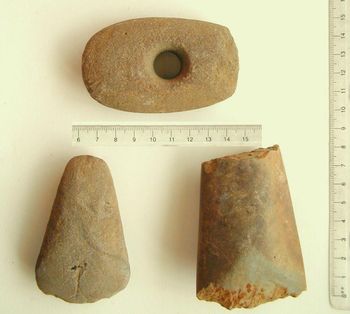Geoffrey and Margaret Appleyard Lithics Collection
Keith Boughey, 2020. https://doi.org/10.5284/1062836. How to cite using this DOI
Data copyright © Keith Boughey unless otherwise stated
This work is licensed under a Creative Commons Attribution 4.0 International License.
Primary contact
Keith
Boughey
Church Bank
Church Hill
Hall Cliffe
Baildon, W. Yorks
BD17 6NE
Resource identifiers
- ADS Collection: 3522
- DOI:https://doi.org/10.5284/1062836
- How to cite using this DOI
Introduction

A large collection of prehistoric worked flints, amounting to over 3500 pieces, was brought to the attention of the applicant towards the end of 2009. Collected between 1972 and 1995 by a husband-and-wife team, Geoff and Margaret Appleyard, of Bradford, West Yorkshire, and their two daughters, it all comes from a group of six adjoining fields N of Thirlsey Farm centred approximately on SE 9805 9208 at 185m O.D., on the extreme NE fringe of the North York Moors overlooking Scalby, a few km NW of Scarborough and the present coastline.
The fields, covering a total of over 30ha, are all on land that slopes and drains gently southwards between the 170m and 190m contours from Silpho Brow until dropping off abruptly into the steep gorges of Thirlsey Bottom flanking Crossdales and Lowdales Becks, tributaries of the River Derwent. The fields are private land belonging to the Malthouse family, who have farmed the area for generations.
The land is covered with a fine pinkish-brown sandy tilth produced from the underlying Oxford clays of the Hackness Basin which in turn sit over the Jurassic sandstone ridge that forms the prominent scarp of Silpho Brow to the north. The fields are regularly sown with spring wheat and other crops and have been given over to the plough for centuries. This has scattered the finds which were all recovered from ploughsoil without any attempts at excavation. Unfortunately, there is no specific provenance for individual pieces, only that they all came from any one of the six fields. However, given the lie and drainage of the land, it seems likely that many of the finds may well have originated from sites further N along the S edge of Silpho Brow and moved gradually southwards over time due to a combination of soil-wash and ploughing.
The collecting methodology was simply for the four members of the family to search each field in turn walking side-by-side along plough furrows between October to March before the spring wheat became too tall. All flint seen was collected, whether obviously worked pieces or waste, bagged, taken home, washed and provisionally sorted into what groups the Appleyards were able to recognise. The Appleyards were not professional archaeologists nor held any recognised qualifications in archaeology, being entirely self-taught, yet in the circumstances did a remarkably good job, making the job of later classification a whole lot easier.
The deposition of this archive was funded by the Yorkshire Archaeological & Historical Society and the Open Access Archaeology Fund.





